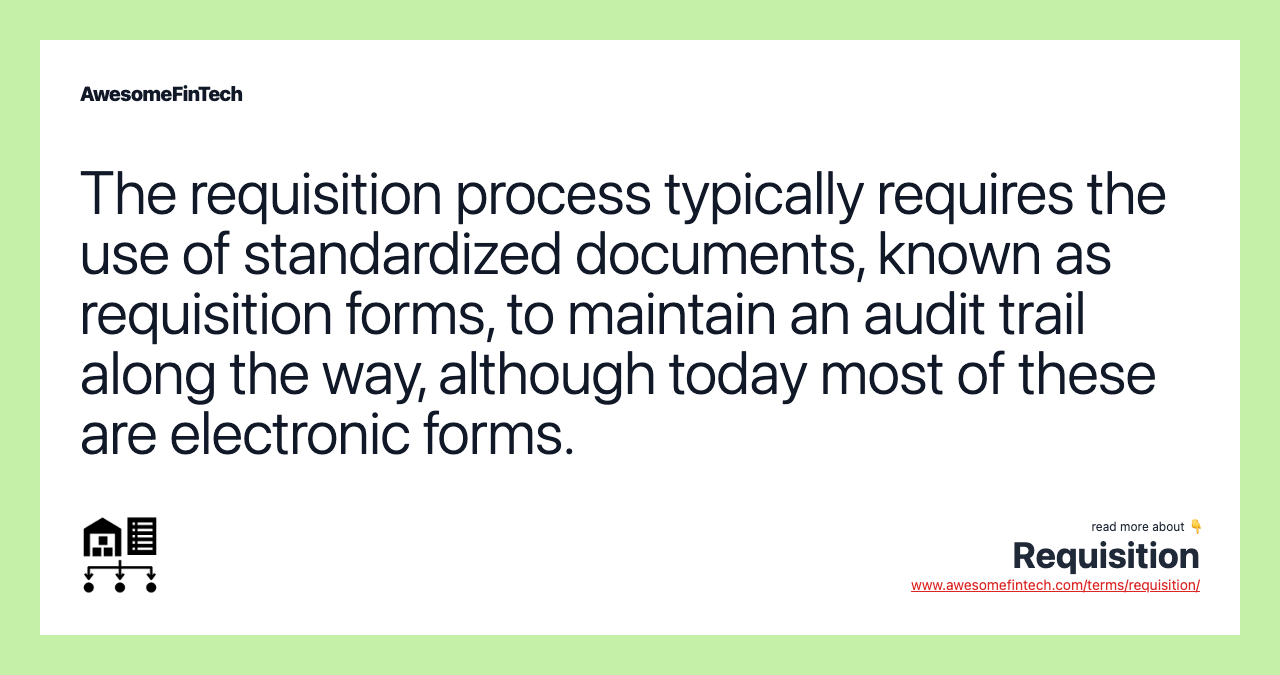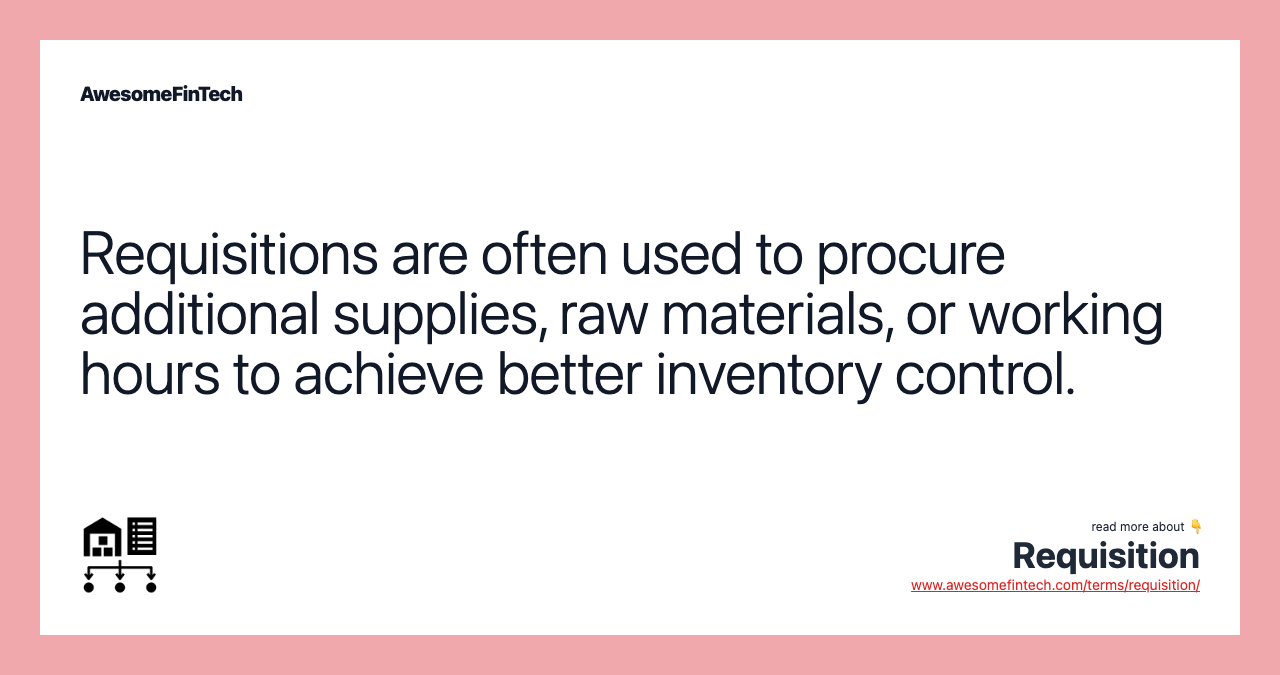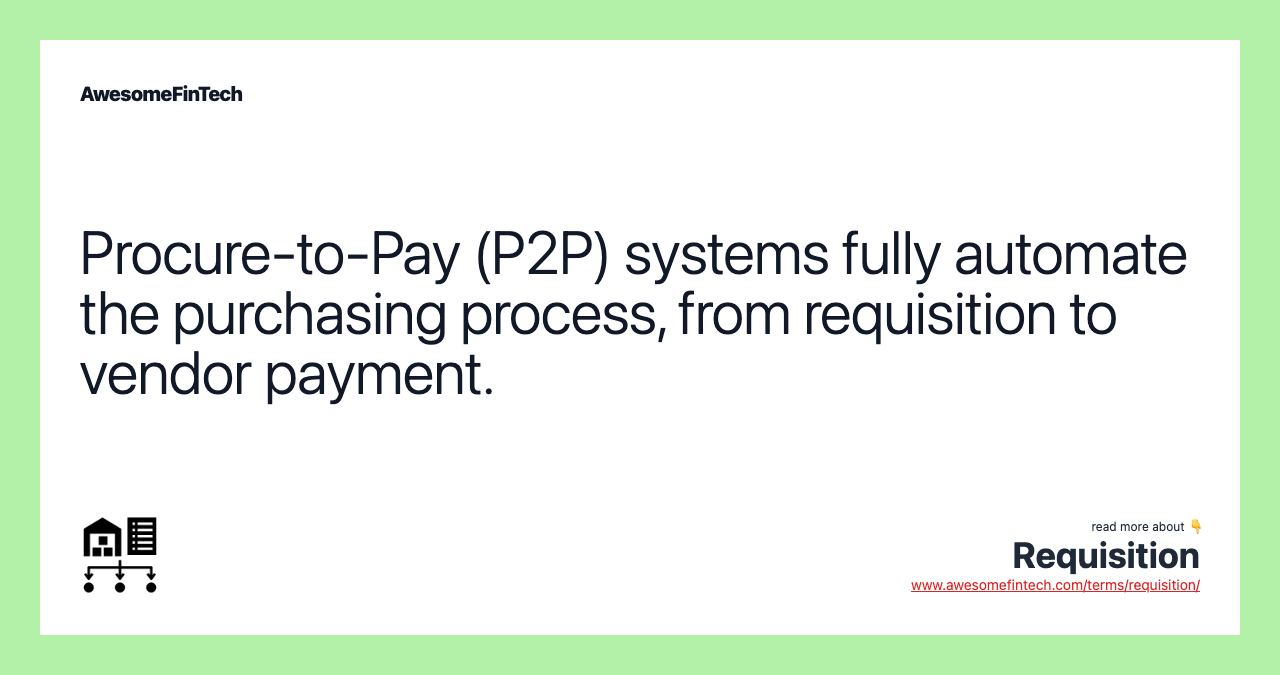Requisition
Table of Contents What Is a Requisition? How a Requisition Works Standardized Requisition Forms Requisition vs. Order Example of a Requisition Special Considerations Requisition FAQs The Bottom Line A requisition refers to the process of formally requesting a service or item, typically using a purchase requisition form or another standardized document. The requisition process typically requires the use of standardized documents, known as requisition forms, to maintain an audit trail along the way, although today most of these are electronic forms. Another example of a requisition process occurs within the world of finance when shareholders choose to requisition a company’s board of directors to take a vote on proposed resolutions. At one time, requisitions were done via paper forms, but most companies now use digital requisition processes that enable easier tracking of the process, including an accounting of relevant inventory.

What Is a Requisition?
A requisition refers to the process of formally requesting a service or item, typically using a purchase requisition form or another standardized document. The requisition process is a standardized way of keeping track of and accounting for all requisitions made within a business.





How a Requisition Works
A requisition initiates the request for a specific action and also records that action for subsequent reporting needs. For example, employees within a company would use a purchase requisition if they needed additional supplies. At one time, requisitions were done via paper forms, but most companies now use digital requisition processes that enable easier tracking of the process, including an accounting of relevant inventory. These types of requisitions oftentimes automatically update the inventory for better controls.
A formalized requisition process improves efficiency and accountability across all points of contact. As opposed to employees taking whatever supplies they want when they want them, the purchase requisition provides a more controlled and documented method for managing internal supply inventories and future demand. For example, in the medical profession, doctors complete a requisition form when requesting lab tests. These digital forms include the patient ID and other medical information, assuring patients receive correct lab tests.
Standardized Requisition Forms
Requisition forms typically include the name of the person making the request, the date of the request, items requested, the delivery date, the delivery location, and the department responsible for fulfilling the request. The forms also include the signature of the individual fulfilling the request and the date completed. In large corporations with multiple locations and centralized purchasing, these requisition processes are critical in maintaining employee productivity.
Another example of a requisition process occurs within the world of finance when shareholders choose to requisition a company’s board of directors to take a vote on proposed resolutions. At its essence, a requisition process is a formalized documented procedure key to improving efficiencies within a business setting.
Purchase Requisition vs. Purchase Order
A purchase requisition is an internal form used for procuring goods and services and has no legal or binding contractual obligations. A purchase order is a contractual agreement used by companies when ordering goods and services from an external vendor. For example, a company ordering supplies from an office store will issue a purchase order detailing the items being purchased, their prices, payment terms, delivery dates, and any special discounts offered for early payment.
The internal purchase requisition form at a company is for employees who wish to request supplies for their departments or themselves. Oftentimes these forms require managerial signoff.
Example of a Requisition
To better understand the requisition process, consider the following example. The Learning and Development team of a health insurance company needs new supplies for its training program. The team lead must request these supplies through the company's automated requisition system.
The lead searches a catalog and selects an assortment of products for the team. After completing the requisition form, it is submitted to management for approval. The manager reviews, approves, and then sends the request to the purchasing department.
Like the manager, the purchasing department reviews and approves the requisition. If errors are present or if not enough information is included, the request may be returned to the manager or the requestor for updates. In this example, there are no errors or omissions; therefore, a purchase order is created for the supplier. The purchase order lists the specifics of the order, such as the product type and the quantity needed. Once final, the purchase order is sent to the supplier for fulfillment.
The supplier receives the order, and if accepted, contracts with the purchaser for the products requested. The purchase order serves as the contract. The supplier delivers the products as requested and receives payment.
Special Considerations
Purchase-to-pay systems (P2P) streamline and automate the requisition and procurement process for companies. Three main processes are cared for by these systems: requisitioning, purchasing, and payment. By automating these processes, purchase-to-pay systems increase efficiency and accuracy in accounting.
Purchase-to-pay systems can reduce costs by approximately 80%.
The automated process begins with requisitioning. Users are presented with a catalog of products or services. Items are then selected and saved in a shopping cart. The requisition is routed to management for approval, and once received, the system moves to the purchasing process and then finalized once payment is made to the vendor.
Requisition FAQs
What Is Requisitioned Property?
Requisitioned property is property taken by the government, such as with eminent domain. In the U.S., the Fifth Amendment requires the government to compensate the owner of seized property; however, the amount of consideration need not be the full market value of the property.
What Is a Job Requisition?
A job requisition is a formal request to hire someone for a job. The requisition contains the details of the job, including desired candidate qualifications, role requirements, and job details. Some companies also post the target salary or salary range in the requisition.
What Is Requisition Reconciliation in Accounting?
Requisition reconciliation in accounting is the process by which two sets of records are compared for accuracy, completeness, and consistency. The comparison will help identify and explain discrepancies. Under generally accepted accounting principles (GAAP), the required double-entry accounting method helps to pinpoint when and where errors exist.
The Bottom Line
A requisition is a formal request for a product or service. Requisitions can be submitted manually or electronically. A structured requisition process improves efficiency and accountability. Procure-to-pay systems fully automate the procurement process, from requisition to payment, which further increases accuracy and efficiency.
Related terms:
Backward Integration
Backward integration is a type of vertical integration that includes the purchase of, or merger with, suppliers. read more
Bid
A bid is an offer made by an investor, trader, or dealer to buy a security that stipulates the price and the quantity the buyer is willing to purchase. read more
Board of Directors (B of D)
A board of directors (B of D) is a group of individuals elected to represent shareholders and establish and support the execution of management policies. read more
Central Purchasing
Central purchasing is a department within a business or organization that is responsible for making all procurements. read more
Corporation
A corporation is a legal entity that is separate and distinct from its owners and has many of the same rights and responsibilities as individuals. read more
Discount
In finance, a discount refers to a situation when a bond is trading for lower than its par or face value. These include pure discount instruments. read more
Efficiency
Efficiency is defined as a level of performance that uses the lowest amount of inputs to create the greatest amount of outputs. read more
Forecasting
Forecasting is a technique that uses historical data as inputs to make informed estimates that are predictive in determining the direction of future trends. read more
Inventory Management
Inventory management is the process of ordering, storing and using a company's inventory: raw materials, components, and finished products. read more
Purchase Order Lead Time
Purchase order lead time is the number of days from when a company orders its production inputs to when those items arrive at the manufacturing plant. read more